Biology:Muscicapa
| Muscicapa | |
|---|---|

| |
| Spotted flycatcher (M. striata) | |
| Scientific classification | |
| Domain: | Eukaryota |
| Kingdom: | Animalia |
| Phylum: | Chordata |
| Class: | Aves |
| Order: | Passeriformes |
| Family: | Muscicapidae |
| Genus: | Muscicapa Brisson, 1760 |
| Type species | |
| Motacilla striata Pallas, 1764
| |
| Species | |
|
see text | |
Muscicapa is a genus of passerine birds belonging to the Old World flycatcher family Muscicapidae, and therein to the typical flycatchers of subfamily Muscicapinae. They are widespread across Europe, Africa and Asia with most species occurring in forest and woodland habitats. Several species are migratory, moving south from Europe and northern Asia for the winter.[1]
They are small birds, 9 to 15 cm (3.5 to 5.9 in) in length. They have a large head, short tail and a flattened bill, broader at the base. Their plumage is mostly drab brown or grey and rather plain. Young birds tend to be more spotted or mottled.[1]
Muscicapa flycatchers typically feed on flying insects which are caught by sallying out from an exposed perch. The nest is usually cup-shaped and built on a tree branch but some African species nest in tree holes.[1]
Taxonomy and systematics
The genus was introduced by the French zoologist Mathurin Jacques Brisson in 1760 with the spotted flycatcher (Muscicapa striata) as the type species.[2][3] The word Muscicapa comes from the Latin musca, a fly and capere, to catch.[4]
In 2010 two large molecular phylogenetic studies of species within Muscicapidae showed that Muscicapa was non-monophyletic. The authors were unable to propose a revised genus as not all the species were sampled.[5][6] A subsequent study published in 2016 included 37 of the 42 Muscicapini species. It confirmed that Muscicapa was non-monophyletic and proposed a reorganised arrangement with several new or resurrected genera.[7]
Extant species
There are 17 extant species of Muscicapa flycatchers:[8]
| Image | Common Name | Scientific name | Distribution |
|---|---|---|---|
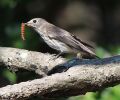 |
Grey-streaked flycatcher | Muscicapa griseisticta | north-east China, North Korea and south-east Siberia including Sakhalin and Kamchatka. In spring and autumn it migrates through eastern and southern China, South Korea, Japan and Taiwan. In winter it occurs in forests, forest edges and open country with scattered trees in Borneo, the Philippines, Palau, eastern Indonesia and New Guinea. It is a vagrant to Singapore, Vietnam, Alaska and Australia. |
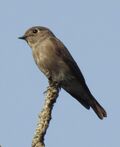 |
Dark-sided flycatcher | Muscicapa sibirica | Asia |
 |
Ferruginous flycatcher | Muscicapa ferruginea | Bangladesh, Bhutan, China, Indonesia, Japan, Laos, Malaysia, Myanmar, Nepal, the Philippines, India, Singapore, Taiwan, Thailand, and Vietnam. |
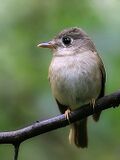 |
Brown-breasted flycatcher | Muscicapa muttui | north eastern India, central and Southern China and northern Burma, Thailand and Vietnam, and migrates to southern India and Sri Lanka. |
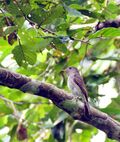 |
Ashy-breasted flycatcher | Muscicapa randi | Philippines |
| Sumba brown flycatcher | Muscicapa segregata | Indonesia | |
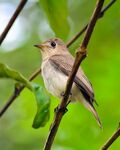 |
Asian brown flycatcher | Muscicapa dauurica[9][10] | Japan, eastern Siberia,southern India, Sri Lanka east to Indonesia and Vietnam, and the Himalayas |
| Brown-streaked flycatcher | Muscicapa williamsoni | southern Myanmar, southern Thailand, northern peninsular Malaysia, and northeast Borneo | |
| Sulawesi streaked flycatcher | Muscicapa sodhii | Sulawesi | |
| Yellow-footed flycatcher | Muscicapa sethsmithi | Cameroon, Central African Republic, Republic of the Congo, Democratic Republic of the Congo, Equatorial Guinea, Gabon, Nigeria, and Uganda. | |
| Little grey flycatcher | Muscicapa epulata | Cameroon, Central African Republic, Republic of the Congo, Democratic Republic of the Congo, Ivory Coast, Equatorial Guinea, Gabon, Ghana, Guinea, Liberia, Nigeria and Sierra Leone | |
 |
African dusky flycatcher | Muscicapa adusta | Africa from Nigeria, the Central African Republic, South Sudan and Ethiopia south to South Africa |
 |
Spotted flycatcher | Muscicapa striata | Mediterranean and Europe to Central Asia, wintering in sub-Saharan Africa |
 |
Mediterranean flycatcher | Muscicapa tyrrhenica | the Balearic Islands, Corsica and Sardinia, and is migratory, wintering in Africa |
| Gambaga flycatcher | Muscicapa gambagae | Burkina Faso, Cameroon, Central African Republic, Chad, Democratic Republic of the Congo, Ivory Coast, Djibouti, Ethiopia, Ghana, Guinea, Kenya, Liberia, Mali, Nigeria, Saudi Arabia, Somalia, Sudan, Togo, Uganda, and Yemen | |
 |
Cassin's flycatcher | Muscicapa cassini | Angola, Benin, Cameroon, Central African Republic, Republic of the Congo, Democratic Republic of the Congo, Ivory Coast, Equatorial Guinea, Gabon, Ghana, Guinea, Liberia, Niger, Nigeria, Rwanda, Sierra Leone, Togo, Uganda, and Zambia |
 |
Swamp flycatcher | Muscicapa aquatica | Benin, Burkina Faso, Burundi, Cameroon, Central African Republic, Chad, Democratic Republic of the Congo, Ivory Coast, Gambia, Ghana, Guinea-Bissau, Kenya, Mali, Niger, Nigeria, Rwanda, Senegal, South Sudan, Tanzania, Togo, Uganda, and Zambia |
Extinct species
There are at least two fossil species which are included in this genus:
- †Muscicapa miklosi (Late Miocene of Polgárdi, Hungary)[11]
- †Muscicapa petenyii (Pliocene of Beremend, Hungary)[11]
Former species
Formerly, some authorities also considered the following species (or subspecies) as species within the genus Muscicapa:
- Red-backed fairywren (as Muscicapa melanocephala)[12]
- Australian golden whistler (as Muscicapa pectoralis)[13]
- New Caledonian whistler (as Muscicapa caledonica)[14]
- Rufous whistler (xanthetraea) (as Muscicapa xanthetraea)[15]
- Little shrikethrush (as Muscicapa megarhyncha)[16]
- Black-naped monarch (as Muscicapa azurea)[17]
- Blue-mantled crested flycatcher (as Muscicapa cyanomelas)[18]
- African paradise flycatcher (as Muscicapa viridis)[19]
- Mascarene paradise flycatcher (as Muscicapa bourbonnensis)[20]
- Hawaiʻi ʻelepaio (as Muscicapa sandwichensis)[21]
- Tahiti monarch (as Muscicapa nigra)[22]
- †Maupiti monarch (as Muscicapa Pomarea)[23]
- Chuuk monarch (as Muscicapa Rugensis)[24]
- Spot-winged monarch (as Muscicapa guttula)[25]
- Hooded monarch (as Muscicapa manadensis)[26]
- Island monarch (as Muscicapa inornata)[27]
- Black-faced monarch (as Muscicapa melanopsis)[28]
- Golden monarch (as Muscicapa chrysomela)[29]
- Frilled monarch (as Muscicapa telescopthalmus)[30]
- Shining flycatcher (chalybeocephala) (as Muscicapa chalybeocephalus)[31]
- Black-capped bulbul (as Muscicapa melanictera)[32]
- Light-vented bulbul (as Muscicapa sinensis)[33]
- Yellow-vented bulbul (as Muscicapa goiavier)[34]
References
- ↑ 1.0 1.1 1.2 Sinclair et al. (2003), Perrins (2004), del Hoyo et al. (2006)
- ↑ Brisson, Mathurin Jacques (1760) (in la, fr). Ornithologie; ou, Méthode contenant la division des oiseaux en ordres, sections, genres, espéces & leurs variétés. &c.. Paris: Jean-Baptiste Bauche. Vol. 1 p. 32, Vol. 2 p. 357.
- ↑ Mayr, Ernst; Cottrell, G. William, eds (1986). Check-list of Birds of the World. 11. Cambridge, Massachusetts: Museum of Comparative Zoology. p. 313. https://biodiversitylibrary.org/page/14484014.
- ↑ Jobling, James A. (2010). The Helm Dictionary of Scientific Bird Names. London, United Kingdom: Christopher Helm. p. 260. ISBN 978-1-4081-2501-4. https://archive.org/details/Helm_Dictionary_of_Scientific_Bird_Names_by_James_A._Jobling.
- ↑ Sangster, G.; Alström, P.; Forsmark, E.; Olsson, U. (2010). "Multi-locus phylogenetic analysis of Old World chats and flycatchers reveals extensive paraphyly at family, subfamily and genus level (Aves: Muscicapidae)". Molecular Phylogenetics and Evolution 57 (1): 380–392. doi:10.1016/j.ympev.2010.07.008. PMID 20656044.
- ↑ Zuccon, D.; Ericson, P.G.P. (2010). "A multi-gene phylogeny disentangles the chat-flycatcher complex (Aves: Muscicapidae)". Zoologica Scripta 39 (3): 213–224. doi:10.1111/j.1463-6409.2010.00423.x.
- ↑ Voelker, G.; Huntley, J.W.; Peñalba, J.V.; Bowie, R.C.K. (2016). "Resolving taxonomic uncertainty and historical biogeographic patterns in Muscicapa flycatchers and their allies". Molecular Phylogenetics and Evolution 94 (Pt B): 618–625. doi:10.1016/j.ympev.2015.09.026. PMID 26475615.
- ↑ Gill, Frank; Donsker, David; Rasmussen, Pamela, eds (July 2023). "Chats, Old World flycatchers". IOC World Bird List Version 13.2. International Ornithologists' Union. https://www.worldbirdnames.org/bow/chats/.
- ↑ Mlíkovský, J. (2012). "Correct name for the Asian Brown Flycatcher (Aves:Muscicapidae, Muscicapa". Zootaxa 3393: 53–56. doi:10.11646/zootaxa.3393.1.4.
- ↑ Dickinson, E.C. (2014). "Correcting the "correct" name for the Asian Brown Flycatcher (Aves: Passeriformes, Muscicapidae, Muscicapa". Zootaxa 3869 (3): 343–347. doi:10.11646/zootaxa.3869.3.8. PMID 25283921. https://www.researchgate.net/publication/266387251.
- ↑ 11.0 11.1 Kessler, E. 2013. Neogene songbirds (Aves, Passeriformes) from Hungary. – Hantkeniana, Budapest, 2013, 8: 37-149.
- ↑ "Malurus melanocephalus (Red-backed Fairywren) - Avibase". https://avibase.bsc-eoc.org/species.jsp?lang=EN&avibaseid=0E9290F8&sec=summary&ssver=1.
- ↑ "Pachycephala pectoralis - Avibase". https://avibase.bsc-eoc.org/species.jsp?lang=EN&avibaseid=0B9A9028&sec=summary&ssver=1.
- ↑ "Pachycephala caledonica - Avibase". https://avibase.bsc-eoc.org/species.jsp?lang=EN&avibaseid=CC0F4D345E5F7FB3.
- ↑ "Pachycephala rufiventris xanthetraea - Avibase". https://avibase.bsc-eoc.org/species.jsp?lang=EN&avibaseid=5B90FC57&sec=summary&ssver=1.
- ↑ "Colluricincla megarhyncha - Avibase". http://avibase.bsc-eoc.org/species.jsp?lang=EN&avibaseid=8B2D4D726807CF21.
- ↑ "Hypothymis azurea - Avibase". http://avibase.bsc-eoc.org/species.jsp?avibaseid=0AC5BA0A3247344C.
- ↑ "Trochocercus cyanomelas - Avibase". http://avibase.bsc-eoc.org/species.jsp?avibaseid=15F017B77422E290.
- ↑ "Terpsiphone viridis - Avibase". http://avibase.bsc-eoc.org/species.jsp?lang=EN&avibaseid=75AAC17B&sec=summary&ssver=1.
- ↑ "Terpsiphone bourbonnensis - Avibase". http://avibase.bsc-eoc.org/species.jsp?avibaseid=3E4F1ABFA195ADDF.
- ↑ "Chasiempis sandwichensis - Avibase". http://avibase.bsc-eoc.org/species.jsp?lang=EN&avibaseid=0E48C9D0&sec=summary&ssver=1.
- ↑ "Pomarea nigra - Avibase". http://avibase.bsc-eoc.org/species.jsp?avibaseid=3B79D9464D4221B0.
- ↑ "Pomarea pomarea - Avibase". http://avibase.bsc-eoc.org/species.jsp?avibaseid=57570D508DB7C66A.
- ↑ "Metabolus rugensis - Avibase". http://avibase.bsc-eoc.org/species.jsp?avibaseid=5159D2D49E00D500.
- ↑ "Symposiachrus guttula - Avibase". http://avibase.bsc-eoc.org/species.jsp?avibaseid=691BA70040A3B373.
- ↑ "Symposiachrus manadensis - Avibase". http://avibase.bsc-eoc.org/species.jsp?lang=EN&avibaseid=EE23F0DC&sec=summary&ssver=1.
- ↑ "Monarcha cinerascens inornatus - Avibase". http://avibase.bsc-eoc.org/species.jsp?lang=EN&avibaseid=9095E115&sec=summary&ssver=1.
- ↑ "Monarcha melanopsis - Avibase". http://avibase.bsc-eoc.org/species.jsp?avibaseid=6ADE606EC30C27E4.
- ↑ "Carterornis chrysomela - Avibase". http://avibase.bsc-eoc.org/species.jsp?avibaseid=6778547AF618FD22.
- ↑ "Arses telescopthalmus - Avibase". http://avibase.bsc-eoc.org/species.jsp?lang=EN&avibaseid=8FCA9FAC&sec=summary&ssver=1.
- ↑ "Myiagra alecto chalybeocephala - Avibase". http://avibase.bsc-eoc.org/species.jsp?lang=EN&avibaseid=0862BCA7&sec=summary&ssver=1.
- ↑ "Pycnonotus melanicterus - Avibase". http://avibase.bsc-eoc.org/species.jsp?lang=EN&avibaseid=8F9DB2BC&sec=summary&ssver=1.
- ↑ "Pycnonotus [sinensis or formosae - Avibase"]. http://avibase.bsc-eoc.org/species.jsp?lang=EN&avibaseid=BB5650EB&sec=summary&ssver=1.
- ↑ (in en) Proceedings of the Zoological Society of London (1832).. Longman. 1854-01-01. https://books.google.com/books?id=V_8NAAAAQAAJ&dq=%22Muscicapa+Goiavier%27&pg=PA278.
Further reading
- del Hoyo, Josep; Elliott, Andrew & Sargatal, Jordi (eds.) (2006): Handbook of Birds of the World (Vol. 11: Old World Flycatchers to Old World Warblers). Lynx Edicions, Barcelona. ISBN:84-96553-06-X (Vol.11: 2006)
- Perrins, Christopher (ed.) (2004): The New Encyclopedia of Birds. Oxford University Press, Oxford. ISBN:0-19-852506-0
- Sinclair, Ian; Ryan, Pete; Christy, Patrice & Hockey, Phil (2003): Birds of Africa: a complete illustrated field guide to the birds of the Sahara. Struik, Cape Town. ISBN:1-86872-857-9
Wikidata ☰ Q1088541 entry
 |

